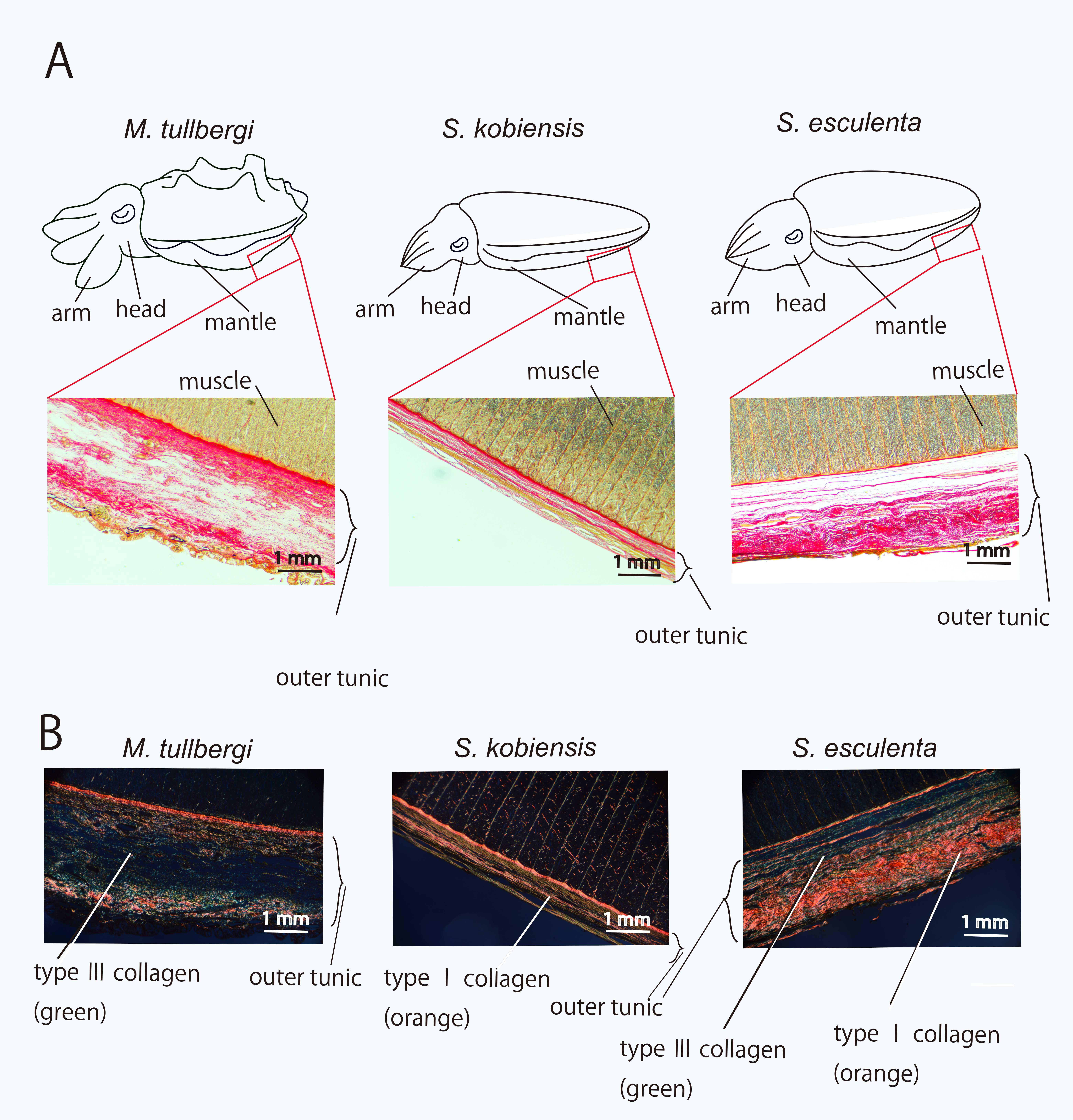Adaptation for Marine Environments by Locomotive Tunic Structure in Cuttlefish
DOI:
https://doi.org/10.58837/tnh.20.2.223110Keywords:
aquatic locomotion, cephalopod, collagen type, cuttlefish, mantle, outer tunicAbstract
Cephalopods have higher motility and more widely distributed in the ocean than other marine invertebrates. Especially members of the family Sepiidae have diverse habitats and locomotory modes. There are inner and outer tunics in the mantle, and the mantle muscle is sandwiched by inner and outer tunics. Their mantle is used for locomotion and respiration, and the tunics of the mantle supports its movements. However, the relationship between the tunic structure and habitats/locomotive modes of cuttlefish remains unclear. In this study, we made histological observations of the outer tunics of three species of Sepiidae with different locomotory modes and quantified the percentages of different collagen types (type Ⅰ collagen: contributing tissue elasticity, type Ⅲ collagen: contributing tissue flexibility). The structure and the collagen types of the outer tunic were related to the habitats and locomotory modes of Sepiidae. In Metasepia tullbergi, which walks on the sea bottom in shallow waters, the outer tunic has a reticular structure that mostly consists of type III collagen. This species’ tunic is suitable for walking in shallower water. In Sepia kobiensis, which swims in deeper depth, the tunic has an oriented layer structure composed of type Ⅰ collagen. This structure is suitable for swimming under higher water pressure. In Sepia esculenta, which swims at shallower depths, the tunic has a thick, reticular structure and is made of both type Ⅰ and III collagen. This structure is suitable for swimming in shallower water. This study reveals Sepiidae have various locomotive tunic structure for adaptations for the diverse marine environment.
References
Fujita, H. and Tsuneo, F. 1981. Textbook of Histology Part 1. Tokyo,Japan: Igaku-Shoin Ltd. p. 14-149.
Gosline, J. M. and Robert, E. S. 1983. Molluscan Collagen and Its Mechanical Organization in Squid Mantle. Vol. 1. Academic Press, INC. p. 371-398.
Gosline, J. M., Steeves J. D., Harman, A. D. and Demont, M. E. 1983. Patterns of Circular and Radial Mantle Muscle Activity in Respiration and Jetting of the Squid Loligo Opalescens. Journal of Experimental Biology, 104: 97-109.
House, L. 1982. Estimation of Types Ⅰand Ⅲ Collagens in Whole Tissue by Quantitation of CNBr Peptides on Sds-Polyacrylamide Gels. Biochemica et Biophyca Acta, 702:30–36.
Ito, T. and Kiichiro, S. 1983. Structures and Functional Properties of Collagen Fibers and Tissues. Sen- i Gakkaishi, 39(10):364–73.
Kangsanant, S., Manee V., and Chakree, T. 2008. Effect of NaCl on Texture Modification of Cuttlefish Mantle (Sepia brevimana). Songklnanakarin Journal of Scinence and Technology, 30(1):11–17.
Kier, W. M. and J. T. Thompson. 2003. Muscle Arrangement, Function and Specialization Recent Coleoids. Coleoid Cephalopods through Time, 3:141–62.
Kimura, S. 1987. The Collagen of Aquatic Animals. Kagaku To Seibutsu, 25(5):311–17.
Kurth, J. A., Thompson, J. T. and Kier, W. M. 2014. Connective Tissue in Squid Mantle Is Arranged to Accommodate Strain Gradients. Biological Bulletin, 227(1):1–6.
Levinton, J. S. and Levinton, J. S. 1995. Marine Biology: Function, Biodiversity, Ecology. New York: Oxford University Press. p. 255-282.
Macgillivray, P. S., Anderson, E. J., Wright, G. M., Demont, M. E. St Francis, P. O. Box, Nova Scotia, and Canada Bg. 1999. Structure and Mechanics of the Squid Mantle. The Journal of Experimental Biology, 202:683–95.
Milligan, B. J., Curtin, N. A. and Bone, Q. 1997. Contractile Properties of Obliquely Striated Muscle from the Mantle of Squid (Alloteuthis subulata) and Cuttlefish (Sepia officinalis). The Journal of Experimental Biology, 200:2425–36.
Murakami, Y., Adachi, H., Sakaida, T., Tanaka, H., Yashiro, Y., and Nakata, S. 2013. The Reduction Mechanism of TheType Ⅲ/ⅠCollagen Ratio with Aging: Age-Related Change in Meprin, a Type 3Ⅲ Collagen Propeptide Cleavage Enzyme. Journal of Society Cosmetic Chemists of Japan, 47(4).
Nagai, T., Yamashita, E., Taniguchi, K. and Kanamori, N. 2001. Isolation and Characterisation of Collagen from the Outer Skin Waste Material of Cuttlefish (Sepia lycidas). Food Chemistry, 72:425–29.
Nixon, M. and Dilly, P. N. 1977. Sucker Surfaces and Prey Capture. Symposium of Zoological Society of London, (38):447–511.
Nixon, M. and Young, Z. J. 2003. The Brains and Lives of Cephalopods. Oxford University. p. 51-77.
Okutani, T. 2015. Cuttlefishs and Squids of the World. Tokai University Press. p. 7-16.
Packard, A. and Trueman, E. R. 1974. Muscular Activity of the Mantle of Sepia and Loligo (Cephalopoda) during Respiratory Movements and Jetting, and Its Physiological Interpretation. Journal of Experimental Biology, 61:411–419.
Packard, B. Y. A. 1974. Muscular Activity of the Mantle of Sepia and Loligo (Cephalopoda) during Respiratory Movements and Jetting, and Its Physiologial Interpretation. Journal of Experimental Biology, 61:411–20.
Ramasamy, P., Namasivayam S., Sadhasivan S., Palaniappan S., Vairamani S., and Annaian S. 2012. Nutritional Evaluation of the Different Body Parts of Cuttlefish Sepia kobiensis Hoyle, 1885. African Journal of Food Science, 6(22):535–38.
Roper, C. F. E and Hochberg, F. G. 1998. Behavior and Systematics of Cephalopods from Lizard Island, Australlia, based on color and body patterns. Malacologia, 29(1): 153-193.
Shadwick, R. E. 2012. Mechanical Organization of the Mantle and Circulatory System of Cephalopods. Marine and Freshwater Behaviour and Physiology, 25:69–85.
Thompson, J. T. and Kier, W. M. 2001a. Ontogenetic Changes in Mantle Kinematics during Escape-Jet Locomotion in the Oval Squid, Sepioteuthis lessoniana Lesson, 1830. The Biological Bulletin 201(2):154–66.
Thompson, J. T. and Kier, W. M. 2001b. Ontogenetic Changes in Fibrous Connective Tissue Organization in the Oval Squid , Sepioteuthis lessoniana Lesson , 1830. Biological Bulletin, 201:136–53.
Ward, D. V. and Wainwright, S. A. 1972. Locomotory Aspects of Squid Mantle Structure. Journal of Zoology, 167(4):437–49.
Young R.E., Vecchione M. and Donovan D. T. 1998. The Evolution of Coleoids and Their Present Biodiversity and Ecology. Cephalopod Biodiversity, Ecology and Evolution, South African Journal of Marine Science, 20: 393-420.

Downloads
Published
How to Cite
Issue
Section
License
Chulalongkorn University. All rights reserved. No part of this publication may be reproduced, translated, stored in a retrieval system, or transmitted in any form or by any means, electronic, mechanical, photocopying, recording or otherwise, without prior written permission of the publisher











